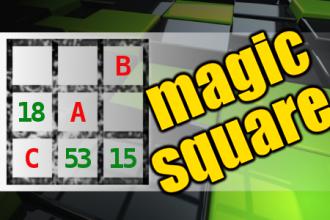MAGIC SQUARE: Calculate A+B*C
The aim is to place the some numbers from the list (14, 15, 18, 26, 27, 30, 47, 49, 50, 53, 67) into the empty squares and squares marked with A, B an C. Sum of each row and column should be equal. All the numbers of the magic square must be different. Find values for A, B, and C. Solution is A+B*C.Correct answers: 40
The first user who solved this task is Djordje Timotijevic.
#brainteasers #math #magicsquare

Women pleasing dog
A man walks into a bar with his dog and orders two glasses of whiskey. He proposes a toast and both he and his dog empty their glasses.
The girl behind the bar is surprised and asks, 'Can your dog perform other tricks?'.
'But of course', the man answers, 'he can even gratify a woman'.
Anxious to know more the girl leads the man and the dog into a little room above the bar. She undresses and full of expectation she lies down on the bed.
The dog looks at her and does nothing.
'It's always the same thing with you!', the man then shouts at the dog, 'Ok, I'll show you how to do this one last time'.

